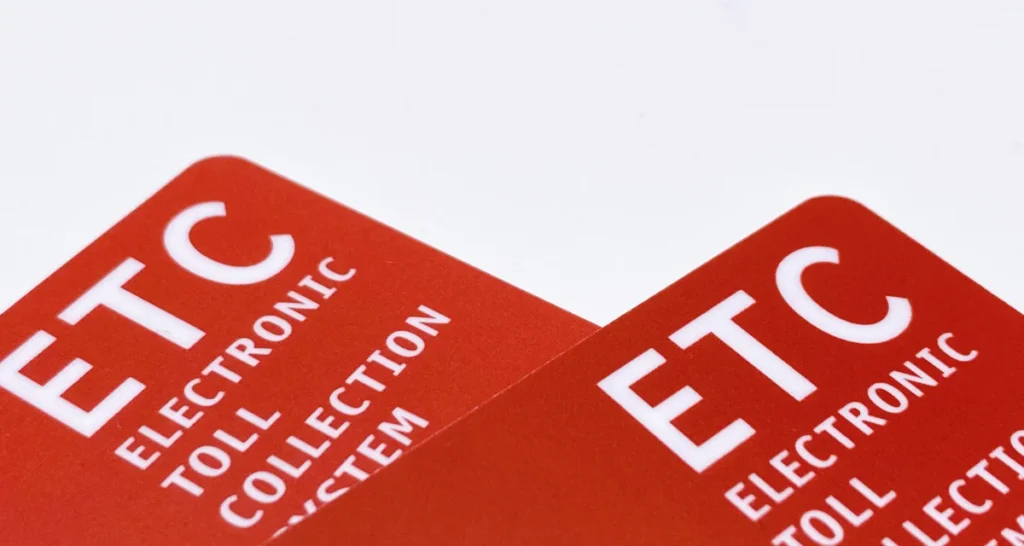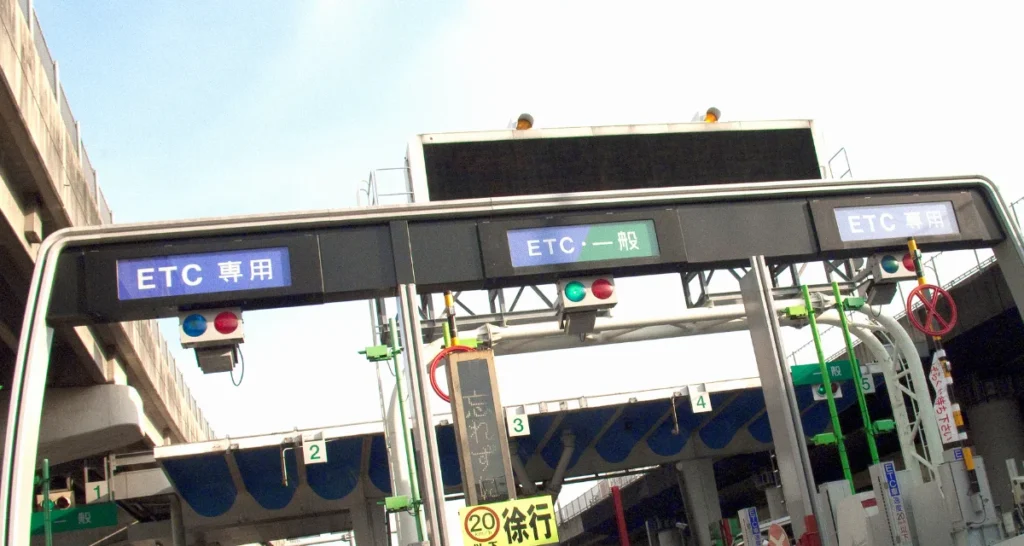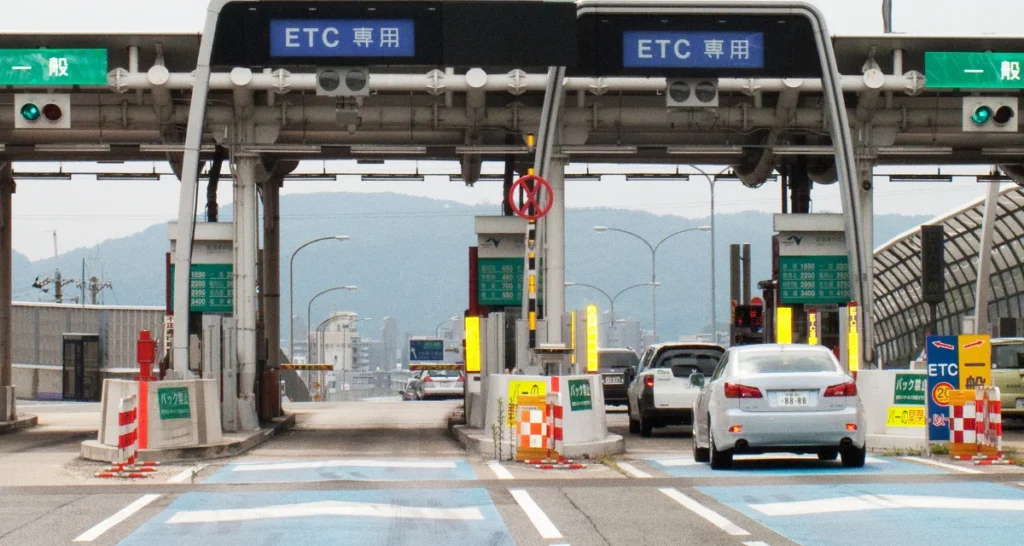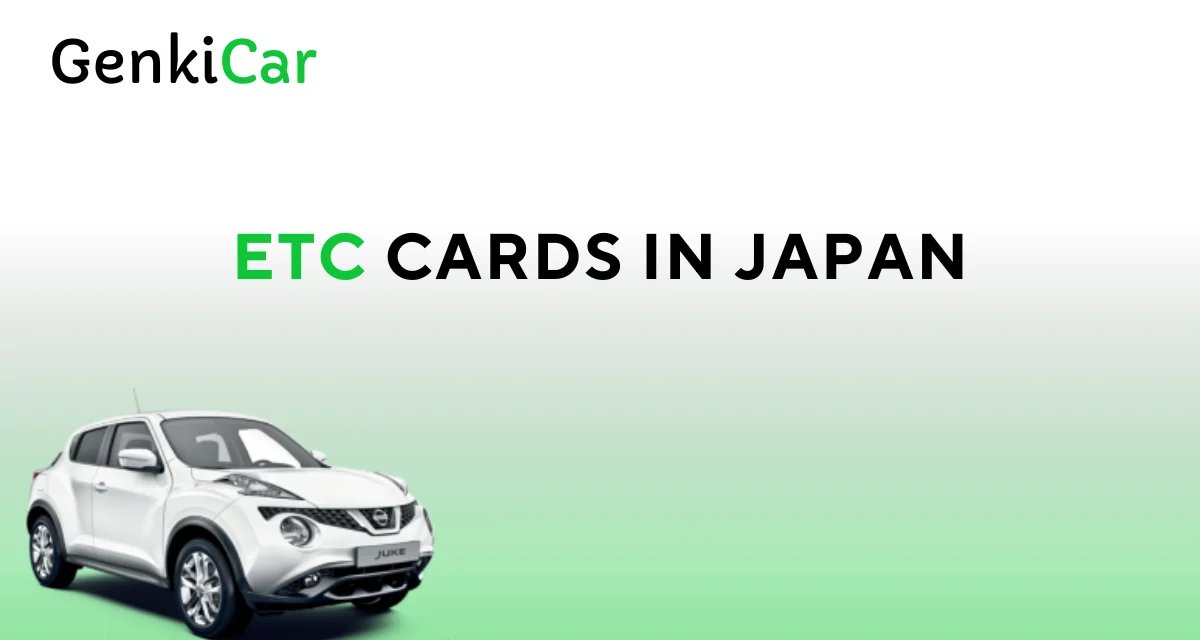ETC (Electronic Toll Collection) cards in Japan is a very important tool for anyone driving on Japan’s highways and expressways. This card allows for automated toll payments, eliminating the need to stop at toll booths and making travel significantly more convenient. When paired with an ETC-compatible onboard device in your vehicle, the ETC card communicates with toll gate systems, deducting the fee directly from your linked account.
For both foreigners and residents in Japan, the ETC system is a game-changer. It not only saves time by allowing non-stop passage through dedicated ETC lanes but also provides exclusive discounts that can result in a good amount of savings, especially for frequent travelers. These discounts are often region-specific or time-based, incentivizing efficient travel planning.
Beyond the obvious convenience and cost-saving benefits, the ETC system reduces traffic congestion at toll booths and contributes to a smoother driving experience. For people unfamiliar with Japan’s extensive expressway network, having an ETC card simplifies the journey by avoiding the need for cash transactions, getting change, or calculating exact change at toll gates.
How to Get ETC Cards in Japan?

Before we go into the process, you should understand the two main types of ETC cards in Japan available: credit-linked ETC cards and ETC Personal Cards.
- Credit-Linked ETC Cards in Japan: These are the most common type and are directly tied to your credit card/Debit card account. The toll fees are automatically charged to your credit card, making very convenient option for those who already have a Japanese credit card. Many credit card providers, including banks and private companies, offer ETC card services as an add-on to existence services.
- ETC Personal Cards: Designed for individuals who do not have or prefer not to use a credit card, ETC Personal Cards provide an alternative. These cards are managed through NEXCO (Nippon Expressway Company) and require a security deposit, which is calculated based on estimated toll usage. Payments are made through a linked bank account, offering a more accessible solution for non-credit card users.
Learn how regular car maintenance complements the use of ETC cards by ensuring your vehicle is always road-ready for expressways in Japan. Check our Ultimate Guide to Car Maintenance in Japan.
Where to Buy ETC Cards in Japan?
You can purchase an ETC card through authorized dealers and platforms that cater to both Japanese residents and foreigners.
- Credit Card Companies: Many Japanese credit card issuers, such as Rakuten, AEON, and JCB, offer ETC cards as an add-on service for their customers. Applications can often be completed online, and the ETC card is mailed to your registered address.
- NEXCO (Nippon Expressway Company): For those opting for an ETC Personal Card, applications can be submitted directly through NEXCO’s website or at designated service counters across Japan.
- Automotive Shops: Major automotive stores like Autobacs and YellowHat sell onboard units (OBUs) and can guide you on where to apply for an ETC card.
ETC Cards in Japan Rentals for Short-Term Visitors
For visitors or temporary residents in Japan, renting an ETC card is a convenient option. Most car rental companies offer ETC card rentals alongside their vehicle services.
- Availability: Popular rental agencies like Nippon Rent-A-Car, Toyota Rent-A-Lease, and Times Car Rental provide ETC cards for short-term use. You simply insert the rental ETC card into the onboard unit of your rented vehicle.
- Benefits: Rental ETC cards save time and effort, allowing visitors to enjoy the convenience of automatic toll payments without having to apply for or buy a card.
- Costs: Rental fees for ETC cards in Japan still apply and typically range between ¥300 and ¥500 per day, with additional toll charges billed at the end of your rental period.
How to Apply for ETC Cards in Japan?
Application Process for Credit Card Holders
Applying for ETC cards in Japan using an existing credit card is the most straightforward option, especially for those who already have a Japanese credit card. Many credit card issuers in Japan offer the ETC card as an additional service.
- Step 1: Check with Your Credit Card Provider
Confirm whether your current credit card issuer supports ETC cards. Popular issuers like Rakuten, JCB, and AEON often include this option, and some providers allow you to apply online. - Step 2: Submit Your Application
Log in to your credit card’s online portal or visit a branch to request an ETC card. Fill out the necessary forms, providing basic details like your name, address, and credit card information. Most applications are quick and straightforward. - Step 3: Receive Your ETC Card
Upon approval, your ETC card will be mailed to your registered address, usually within 1–2 weeks. It is immediately linked to your credit card, so toll fees are automatically charged to your credit account.
Pro Tip: Some credit card issuers offer promotions or waived application fees for new ETC cardholders, so it’s worth exploring your options.
How to Apply for an ETC Personal Card in Japan
As mentioned earlier, ETC Personal Card is a viable alternative. Managed by NEXCO, this card is directly connected to your bank account and requires a deposit.
- Step 1: Gather Necessary Documents
You’ll need valid identification (e.g., residence card or Japanese driver’s license), proof of address, and your bank account information. Prepare these before starting your application. - Step 2: Apply Through NEXCO
Visit NEXCO’s official website or a designated service counter to complete the application. Fill out the form with your personal details and bank information. The application process may require some assistance if you’re not fluent in Japanese. - Step 3: Pay the Deposit
NEXCO requires a refundable security deposit for ETC Personal Cards. This amount is based on your estimated toll usage, starting at ¥20,000. The deposit ensures coverage for toll fees in case of payment issues. The deposit is calculated by comparing two values:
Four times your expected monthly usage, rounded up to the nearest ¥5,000 (minimum ¥10,000).
Your maximum monthly usage, rounded up to the nearest ¥20,000.
The higher of these two amounts is required as the deposit. For example, if your expected monthly usage is ¥3,500, it’s rounded up to ¥10,000, making the deposit ¥40,000. If your maximum usage is ¥48,000, it rounds to ¥60,000, which becomes the deposit. After receiving the card, you may need to adjust the deposit based on actual usage.
- Step 4: Receive Your ETC Card
Once your application is approved and the deposit is processed, your ETC Personal Card will be sent to your registered address. - Payment Method: Toll fees are deducted directly from your linked bank account, making this option accessible even for those without a credit card.
Both methods ensure smooth access to Japan’s ETC system, with credit-linked ETC cards being the fastest option and ETC Personal Cards catering to those without credit cards. Select the one that best suits your needs to start enjoying the convenience of automated toll payments.
Top 5 Benefits of Using ETC Cards in Japan
1. Saves Time by Bypassing Toll Booths
One of the most significant advantages of using ETC cards in Japan is the time it saves. Instead of stopping at traditional toll booths to pay in cash or with a card, the ETC system allows drivers to pass through dedicated lanes without stopping. This seamless experience reduces wait times, especially during peak travel hours or holiday periods when toll booths are typically congested.
Looking for a trusted dealership in Japan? Let us help! Get in touch to connect you with top-rated, English-speaking dealers nearby.
2. Access to Discounts and Regional Toll Promotions
ETC cardholders enjoy exclusive discounts and promotional offers on Japan’s expressways. For example, some regions offer reduced toll rates during off-peak hours, weekends, or on specific routes. These discounts are automatically applied when using the ETC system, making it a cost-effective choice for frequent travelers. Certain programs, like regional expressway passes, also provide unlimited toll access for a fixed fee, but only for ETC users.
3. Convenience for Long-Distance Travelers
For those embarking on long road trips or daily commutes, the ETC system provides unparalleled convenience. Drivers can focus on the journey without worrying about carrying exact change or stopping repeatedly at toll booths. This benefit is especially valuable for foreigners unfamiliar with Japan’s toll payment process, as it simplifies navigation and reduces the stress of travel.
4. Easy Tracking of Toll Expenses
ETC cards in Japan, keep track of toll expenses then become straightforward. Whether linked to a credit card or a personal account, your toll payments are itemized on monthly statements, providing clear documentation of travel costs. This is particularly useful for business travelers or individuals who need to manage budgets or claim expenses for reimbursement. Especially if linked to Revolut or Wise.
5. Reduced Fuel Consumption
Frequent stops and starts at toll booths can waste fuel, especially during heavy traffic. By allowing uninterrupted travel through ETC lanes, the system helps optimize fuel efficiency. Over time, this translates to both environmental benefits and cost savings, making it a more sustainable and economical choice for regular highway users.
How to Use ETC Cards in Japan on Highways?

Setting Up Your ETC Cards in Japan with Device
Before you can start using your ETC card in Japan, you’ll need to ensure your vehicle is equipped with an Onboard Unit (OBU), a small electronic device that communicates with toll gate antennas. If you’re purchasing a car in Japan, make sure it’s equipped with an onboard ETC unit for smooth toll payments.
- Installing the Onboard Unit (OBU):
OBUs are widely available at automotive stores like Autobacs or Yellow Hat and can also be purchased online. Once you have your OBU, installation is typically handled by professionals at the store or your car dealership to ensure proper setup and configuration with your vehicle. - Inserting the Card and Testing the Setup:
After the OBU is installed, insert your ETC card into the designated slot. It’s important to hear a confirmation beep or see a display light on the OBU, indicating the card has been recognized. Some OBUs also provide audio feedback, such as “ETC card is ready,” to confirm successful setup. Test the system in a safe environment before heading to the highways.
ETC Toll Booths Safely
Once your ETC card and OBU are set up, you’re ready to use the system on Japan’s highways. Here are some tips to use the toll booths safely and efficiently:
- Identifying ETC Lanes:
ETC lanes are clearly marked with purple signs featuring the ETC logo. Most toll gates have dedicated lanes for ETC users, often positioned on the far left or right of the toll booth area. Make sure to enter the correct lane to avoid delays or confusion. - Recommended Speed and Precautions:
Approach the ETC lane at the recommended speed, usually 20 km/h or less, to allow the system to accurately read your OBU. Keep an eye on the lane’s signal light:- Green Light: Proceed, as your card has been recognized.
- Red Light: Stop immediately and contact the toll gate attendant for assistance. This may occur if the card is not properly inserted or has expired.
- Drive Carefully Through the Gate:
Avoid sudden stops or acceleration, and maintain a safe distance from the vehicle ahead to prevent collisions in case the gate malfunctions. Always double-check that your ETC card is securely inserted before starting your journey to avoid interruptions.

Talking about safety, understanding Japanese traffic laws can enhance your experience using ETC cards. Make sure you check out our blog post Guide to Japanese Traffic Laws for Foreign Drivers.
Frequently Asked Questions About ETC Cards in Japan
How Can You Make ETC Cards in Japan?
Creating an ETC card in Japan is straightforward. You can apply through a credit card company or directly with NEXCO for an ETC Personal Card. If you already hold a Japanese credit card, the process is quick, often done online, and requires minimal paperwork. For those without a credit card, the ETC Personal Card provides an accessible alternative. This option requires identification, proof of residence, and a refundable deposit calculated based on estimated toll usage.
Is It Possible to Get ETC Cards Without a Japanese Credit Card?
Yes, you can still obtain an ETC card without a Japanese credit card by applying for an ETC Personal Card. Managed by NEXCO, this option connects the card to your bank account, bypassing the need for credit. Along with basic documentation, you’ll need to provide a deposit to secure the card, ensuring you can still benefit from the ETC system’s convenience and discounts.
What Should You Do If the ETC System Fails at a Toll Gate?
If the ETC system doesn’t read your card or the toll gate fails to open, remain calm and stop your vehicle safely. An attendant will assist in resolving the issue. Common causes include improper card insertion, an expired card, or a technical issue with the onboard unit. In such cases, you may need to pay the toll manually in cash or via an alternative method until the issue is resolved.
What Happens If I Lose My ETC Card?
If you lose your ETC card in Japan, report it immediately to the issuing company (credit card provider or NEXCO). They will deactivate the card to prevent unauthorized use and issue a replacement. Replacement fees may apply, depending on the provider.
Can Foreigners Apply for ETC Cards in Japan?
Yes, foreigners can apply for an ETC card in Japan. Credit-linked ETC cards require you to have a Japanese credit card, while ETC Personal Cards are available to those with a valid residence card and a Japanese bank account. The process is accessible, but some providers may require assistance with Japanese documentation.
Do ETC Cards Work Nationwide in Japan?
Yes, ETC cards are universally accepted on all highways and expressways in Japan. The system is standardized, so you can use the same card across regions without any additional registration or compatibility issues.
Are There Any Fees Associated with ETC Cards in Japan?
For credit-linked ETC cards in Japan, some issuers charge a small annual fee (typically around ¥500–¥1,500), while others may waive the fee. For ETC Personal Cards, a deposit is required, but no additional annual fee is charged.
Can I Use an ETC Card in a Rental Car?
Yes, you can use your own ETC card in a rental car, provided the vehicle is equipped with an onboard unit. Alternatively, many rental agencies offer ETC cards for short-term use, making it convenient for tourists or temporary residents.
Can I Share an ETC Card Between Multiple Vehicles?
While you can technically use the same ETC card in multiple vehicles, it is important to note that the onboard unit (OBU) must be configured correctly for each car. Always confirm compatibility with the OBU before switching vehicles.
What Should I Do If My ETC Card Expires?
Renew your ETC card through your issuing provider before it expires. Most companies send reminders and replacement cards automatically. If your card expires unexpectedly, you’ll need to pay tolls manually until you receive the new card.
Are There Special ETC Programs for Tourists?
Yes, programs like the Hokkaido Expressway Pass and Tohoku Expressway Pass offer unlimited expressway access for tourists at a fixed rate. These passes require an ETC card, and rental agencies often include them as part of their packages.
Can I Cancel My ETC Card?
You can cancel your ETC card by contacting the issuing company. For ETC Personal Cards, your deposit will be refunded, provided there are no outstanding toll charges. Ensure all pending payments are settled before cancellation.





